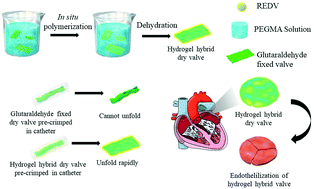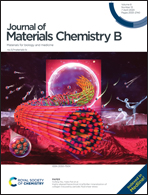Pre-mounted dry TAVI valve with improved endothelialization potential using REDV-loaded PEGMA hydrogel hybrid pericardium†
Abstract
The pre-mounted dry transcatheter aortic valve implantation (TAVI) valve is a new technology in the development of biological heart valves. Dry valves do not need to be placed in special preservation solution and can be opened and used immediately, meeting the needs of clinical emergency valve implantation. However, current biological valves obtained by simple air drying cannot be unfolded quickly. In addition, the crimping process leads to structural damage to the valve fiber microstructure, reducing the service life of biological valves. Furthermore, current biological valves still have problems such as calcification, endothelialization difficulty, and immune rejection. In this study, a poly(ethylene glycol)methacrylate (PEGMA) hydrogel hybrid pericardium loaded with REDV was developed. The PEGMA monomer solution can penetrate the space of the pericardium. REDV was loaded into the PEGMA hydrogel, which was hybridized with pericardium via in situ polymerization. The results showed improved unfolding properties, less mechanical damage after crimping, and improved endothelialization potential of the biological valve. Thus, REDV-loaded PEGMA hydrogel hybrid pericardium is a promising approach for obtaining pre-mounted dry TAVI valves with enhanced endothelialization properties.



 Please wait while we load your content...
Please wait while we load your content...